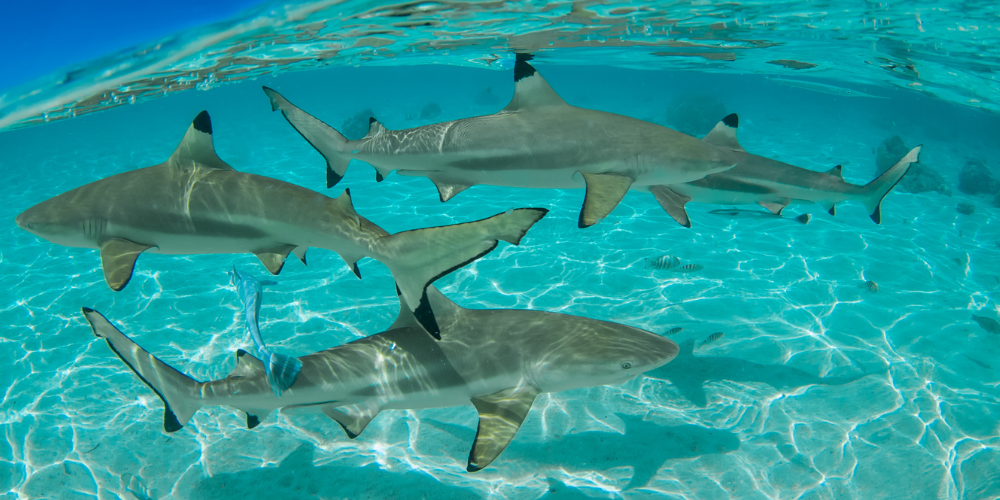Did you know sharks have been swimming in our oceans for over 400 million years?
That was before dinosaurs roamed the Earth! These fascinating creatures have intrigued us for centuries, and their social behavior is just as captivating as their ancient history.
So, what do you call a group of sharks? Let’s dive in and find out!
A group of sharks is often referred to by various collective nouns such as “shiver,” “frenzy,” “herd,” “gam,” or “school.” These terms are used interchangeably and informally, with no single conventional term universally accepted.
The most commonly used term is “shiver.” The origins of this term are somewhat unclear, but it’s thought to derive from the old English word “scirfer”, which means “to cut or separate.”
This could reference how a group of sharks can appear to cut through the water.
So, next time you see sharks in a group, you can impress your friends by casually mentioning the “shiver” of sharks!
Exploring Other Collective Nouns for Sharks
While “shiver” is the most commonly used term, several other collective nouns can be used to describe a group of sharks.
These terms can be used interchangeably, and their usage often depends on the context or personal preference. Here are some of them:
Frenzy
The term “frenzy” is often used to describe a group of sharks, particularly when feeding.
The word itself connotes a wild or uncontrolled activity, perfectly encapsulating sharks’ energetic and ferocious nature during a feeding event.
It’s a term that paints a vivid picture of the chaos and excitement that can occur when these powerful predators gather to feast.
Herd
While the term “herd” is traditionally associated with groups of large land mammals, it’s also used in the context of sharks.
This term emphasizes sharks moving together in large groups, much like a herd of cattle or elephants. It’s a term that suggests a sense of unity and collective movement among these marine creatures.
Gam
The term “gam” is often used by sailors and whalers to describe a social meeting of sea creatures, including sharks.
This term underscores the social aspect of shark behavior, an often overlooked characteristic.
It suggests that sharks, like humans, have social interactions and gatherings, adding a new layer of complexity to our understanding of these creatures.
School or Shoal
While the terms “school” or “shoal” are more commonly associated with groups of fish, they can also apply to sharks, especially when they are seen swimming together in large numbers.
The usage of these terms often depends on the context or personal preference. They highlight different aspects of shark behavior, allowing us to describe and understand these creatures more nuancedly.
So, the next time you see a group of sharks consider which collective noun best captures the scene before you!
Why So Many Names for a Group of Sharks?
Language is a living, evolving entity like the creatures it describes. It grows, adapts, and changes to fit the needs and understandings of its users.
The English language, in particular, is known for its abundance of collective nouns, a testament to its richness and creativity.
The variety of terms used to describe a group of sharks is a perfect example of this linguistic diversity.
But why so many names for a group of sharks?
The answer lies in the intersection of language, culture, and our understanding of these marine creatures.
Reflecting on Characteristics and Behaviors
Collective nouns often reflect the characteristics or behaviors of the animals they describe.
For instance, a “frenzy” of sharks captures the chaotic and energetic nature of sharks during feeding time.
Similarly, a “shiver” of sharks evokes an image of sharks moving swiftly and smoothly through the water, much like a shiver running down one’s spine.
Cultural and Historical Influences
The variety of collective nouns also reflects cultural and historical influences. Different communities may coin their terms based on their interactions and experiences with sharks.
For instance, sailors and whalers used the term “gam” to describe a social gathering of sea creatures, including sharks.
Evolution of Language
Language is not static; it evolves. New words and phrases are constantly being added while others fall out of use.
The variety of terms for a group of sharks reflects this dynamism. As our understanding of sharks deepens and changes, so does the language we use to describe them.
Collective Nouns for Different Types of Sharks
Interestingly, there are no specific collective nouns for different types of sharks. Whether it’s a group of great white sharks or a gathering of hammerhead sharks, the same collective nouns apply.
However, the diversity and adaptability of the English language always leave room for innovation.
Who knows?
You might coin the next popular term for a group of your favorite type of shark!
Comparison with Other Sea Creatures
Just as there are multiple terms for a group of sharks, other sea creatures also boast a variety of collective nouns.
These terms, often unique and whimsical, add a touch of poetry to our language and deepen our connection with the natural world.
A Smack of Jellyfish
A group of jellyfish is known as a “smack”.
This term might seem unusual initially, but it’s thought to derive from the German “schmeck”, a term used in the 18th century to describe a group of jellyfish.
The term “smack” captures the visual impact of seeing a large group of these gelatinous creatures floating together in the water.
A Pod of Dolphins
Dolphins, known for their social and playful nature, are called a “pod” in a group.
This term emphasizes the close-knit social structures of dolphin communities. Dolphins are known to form complex social networks, and the term “pod” reflects this sense of community and cooperation.
Other Notable Collective Nouns
There are many other interesting collective nouns for sea creatures. For instance, a group of squid is known as a “squad,” a term that reflects the coordinated and synchronized way these creatures move together.
A group of whales can be referred to as a “pod”, a “school”, or even a “gam”, much like sharks.
These collective nouns not only enrich our language but also provide insights into the behaviors and characteristics of these sea creatures.
They remind us of the diversity and wonder of the marine world, encouraging us to learn more and deepen our understanding of these fascinating creatures.
Conclusion
From the chilling “shiver” to the chaotic “frenzy,” the collective nouns for a group of sharks are as diverse and fascinating as the creatures themselves.
These terms, steeped in cultural and historical influences, offer a unique lens through which we can appreciate and understand these magnificent marine predators.
But the richness of our language doesn’t stop at sharks. As we’ve seen, the sea of collective nouns also extends to other marine creatures, each term painting a vivid picture of the creature it represents.
A “smack” of jellyfish, a “pod” of dolphins, a “squad” of squid – these phrases evoke images and stories, adding depth and color to our conversations about the natural world.
So, the next time someone asks you, “What do you call a group of sharks?” you’ll have not just one but several answers to give them!
You can share the commonly used “shiver”, or perhaps the dramatic “frenzy”, or even the historical “gam”. Each term offers a different perspective and story about these fascinating creatures.
In the end, these collective nouns do more than describe groups of animals. They reflect our understanding and perception of these creatures.
They capture the awe and wonder we feel when we observe the natural world. And most importantly, they remind us of the richness and diversity of life on our planet.
Remember to check out our other articles on sharks and marine life:
Stay curious, and keep exploring the fascinating world of sharks and other marine creatures!
Frequently Asked Questions
Do Tiger Sharks Go in Groups?
Tiger sharks can be found in groups, particularly during periods of abundant food. However, they are also known for their solitary hunting habits.
Do Tiger Sharks Live in Groups?
While tiger sharks are not as social as other shark species, they can gather in large groups in areas with abundant food or during mating seasons.
Do Tiger Sharks Swim in Groups?
Tiger sharks exhibit both solitary and group swimming behaviors. Food availability, mating, or specific environmental conditions often influence the tendency to group.
REFERENCES:
- A quiz: what do you call a group of sharks?” (2015, July 23). Seattle Aquarium. Retrieved from https://www.seattleaquarium.org/blog/quiz-what-do-you-call-group-sharks
- “What is a group of sharks called?” (n.d.). Homework.Study.com. Retrieved from https://homework.study.com/explanation/what-is-a-group-of-sharks-called.html
- “14 Funny and Weird Collective Nouns from the English Language” (2019, August 5). Jellyfish. Retrieved from https://www.jellyfish.com/en-gb/training/blog/collective-nouns.




